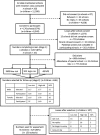The impact of nonverbal ability on prevalence and clinical presentation of language disorder: evidence from a population study
- PMID: 27184709
- PMCID: PMC5082564
- DOI: 10.1111/jcpp.12573
The impact of nonverbal ability on prevalence and clinical presentation of language disorder: evidence from a population study
Abstract
Background: Diagnosis of 'specific' language impairment traditionally required nonverbal IQ to be within normal limits, often resulting in restricted access to clinical services for children with lower NVIQ. Changes to DSM-5 criteria for language disorder removed this NVIQ requirement. This study sought to delineate the impact of varying NVIQ criteria on prevalence, clinical presentation and functional impact of language disorder in the first UK population study of language impairment at school entry.
Methods: A population-based survey design with sample weighting procedures was used to estimate population prevalence. We surveyed state-maintained reception classrooms (n = 161 or 61% of eligible schools) in Surrey, England. From a total population of 12,398 children (ages 4-5 years), 7,267 (59%) were screened. A stratified subsample (n = 529) received comprehensive assessment of language, NVIQ, social, emotional and behavioural problems, and academic attainment.
Results: The total population prevalence estimate of language disorder was 9.92% (95% CI 7.38, 13.20). The prevalence of language disorder of unknown origin was estimated to be 7.58% (95% CI 5.33, 10.66), while the prevalence of language impairment associated with intellectual disability and/or existing medical diagnosis was 2.34% (95% CI 1.40, 3.91). Children with language disorder displayed elevated symptoms of social, emotional and behavioural problems relative to peers, F(1, 466) = 7.88, p = .05, and 88% did not make expected academic progress. There were no differences between those with average and low-average NVIQ scores in severity of language deficit, social, emotional and behavioural problems, or educational attainment. In contrast, children with language impairments associated with known medical diagnosis and/or intellectual disability displayed more severe deficits on multiple measures.
Conclusions: At school entry, approximately two children in every class of 30 pupils will experience language disorder severe enough to hinder academic progress. Access to specialist clinical services should not depend on NVIQ.
Keywords: Developmental language disorder; NVIQ discrepancy; functional impairment; prevalence.
© 2016 The Authors. Journal of Child Psychology and Psychiatry published by John Wiley & Sons Ltd on behalf of Association for Child and Adolescent Mental Health.
Figures


References
-
- Adams, C. , Cooke, R. , Crutchley, A. , Hesketh, A. , & Reeves, D. (2001). Assessment of comprehension and expression 6‐11. GL assessment. Available from: http://www.gl-assessment.co.uk/products/assessment-comprehension-and-exp... [last accessed 27 April 2016].
-
- American Psychiatric Association (2013). Diagnostic and statistical manual of mental disorders (5th edn). Washington, DC: Author.
-
- Beitchman, J.H. , Nair, R. , Clegg, M. , & Patel, P.G. (1986). Prevalence of speech and language disorders in 5‐year‐old kindergarten children in the Ottawa‐Carleton region. Journal of Speech and Hearing Disorders, 51, 98. - PubMed
-
- Bishop, D.V.M. (2003a). Children's communication checklist‐2. London: Pearson.
-
- Bishop, D.V.M. (2003b). Test for reception of grammar (TROG‐2) (2nd edn). London, UK: Pearson Assessment.
Publication types
MeSH terms
Grants and funding
LinkOut - more resources
Full Text Sources
Other Literature Sources
Medical

